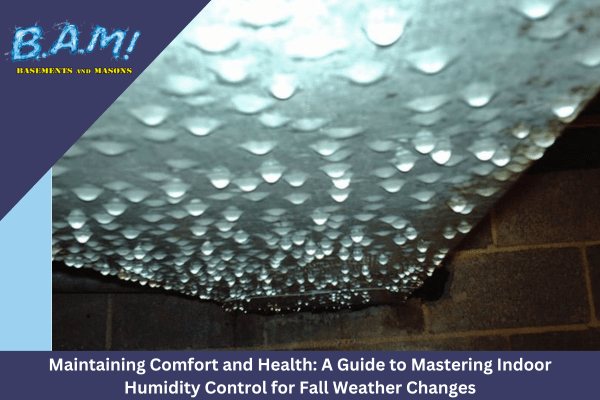As the crisp fall air rolls in, we find ourselves saying farewell to the sweltering summer heat. The transition from summer to fall brings a welcome relief, but it also ushers in a new set of challenges, particularly when it comes to indoor humidity control. Maintaining the right level of humidity inside your home during the fall season is crucial for comfort, health, and the preservation of your property. In this blog, we'll explore the fundamentals of indoor humidity control for fall weather changes, helping you create a cozy and healthy living environment.
Understanding Indoor Humidity
Before delving into the specifics of controlling indoor humidity during the fall, it's important to understand what humidity is and why it matters. Humidity refers to the amount of moisture or water vapor present in the air. It's typically expressed as a percentage, with 100% humidity indicating that the air is saturated with moisture and cannot hold any more. The ideal indoor humidity level for most homes typically ranges between 30% and 50%.
Why is indoor humidity control important?
Comfort: Maintaining the right humidity level is essential for your comfort. Too much humidity can make your home feel stuffy and uncomfortable, while too little can lead to dry skin, irritated eyes, and respiratory problems.
Health: Proper humidity control is crucial for your health. Excessively dry air can exacerbate allergies, asthma, and other respiratory issues. On the other hand, high humidity can promote mold and dust mite growth, which can trigger allergies and respiratory problems as well.
Preservation: Indoor humidity also plays a significant role in preserving your property. Too much moisture can lead to structural damage, such as wood rot and mold growth, while excessive dryness can cause wood to shrink and crack.
Fall Weather and Indoor Humidity
As fall approaches, the outdoor air becomes drier, which can impact the humidity levels inside your home. Here's how fall weather changes affect indoor humidity:
Outdoor humidity drops: During the fall, the air becomes cooler and holds less moisture. This drop in outdoor humidity levels can lead to lower indoor humidity if not properly controlled.
Heating systems are in use: As the temperature drops, we turn on our heating systems to keep our homes warm. These systems can further reduce indoor humidity because they tend to dry out the air.
Controlling Indoor Humidity in the Fall
Now that we understand the importance of indoor humidity control during the fall, let's explore some effective strategies to maintain the right moisture level:
Use a hygrometer: Invest in a hygrometer, a device that measures humidity levels in your home. This will help you monitor and adjust humidity as needed.
Humidifiers: During the fall, when indoor air tends to be dry, consider using a humidifier to add moisture to the air. There are different types of humidifiers available, including cool mist and warm mist, so choose one that suits your preferences and needs.
Dehumidifiers: If your area experiences high humidity during the fall, a dehumidifier can help maintain a healthy humidity level. Dehumidifiers remove excess moisture from the air, preventing mold growth and improving indoor air quality.
Seal gaps and cracks: Properly sealing gaps and cracks in your home's windows and doors can help prevent outdoor air from seeping in, which can reduce humidity levels. Weatherstripping and caulking are effective solutions.
Use exhaust fans: Cooking and showering can add moisture to the air. Be sure to use exhaust fans in the kitchen and bathroom to remove excess humidity.
Adjust your thermostat: Lowering your thermostat slightly can reduce the drying effect of your heating system. Additionally, using a programmable thermostat to maintain a steady indoor temperature can help control humidity.
Ventilation: When the outdoor air is less humid, opening windows and doors for a brief period can allow fresh air to circulate, helping to balance indoor humidity levels.
Houseplants: Certain houseplants, such as peace lilies and spider plants, can help regulate indoor humidity by releasing moisture into the air through a process called transpiration.
Call the Professionals for Basement Humidity Control
Mastering your home's indoor humidity control for fall weather changes is essential for a comfortable and healthy living environment. By understanding the fundamentals of humidity, monitoring your home's moisture levels, and implementing the right strategies, you can ensure that your home remains a cozy and welcoming retreat as the leaves begin to fall. Whether it's investing in a humidifier, sealing gaps, or adjusting your thermostat, taking proactive steps to maintain the right indoor humidity level will make your fall season more enjoyable and stress-free.
Let BAM help choose the right dehumidifier for your home!
At BAM basements and Masons of Des Moines we believe in and install Aprilaire dehumidifiers. AprilAire has been the leader in humidity control since 1954. They have a 5-year warranty and are manufactured in the USA. Call us to get your free estimate on your home’s dehumidifier needs.
BAM Basements and Masons of Des Moines is your premier Dehumidifier company serving the Des Moines, Iowa area. If you’re located in Des Moines, Ankeny, Bondurant, Altoona, Pleasant hill, Ames, Boone, Adel, Waukee, Indianola, Grimes, Urbandale, Johnston, West Des Moines, or the surrounding areas, we’re the place to call. BAM Basements and Masons of Des Moines is a professional and locally owned and operated state-registered contractor. We offer affordable honest upfront pricing, no hidden costs, offer free estimates and limited lifetime warranties. We use new methods and materials on all jobs. We would love to help!

